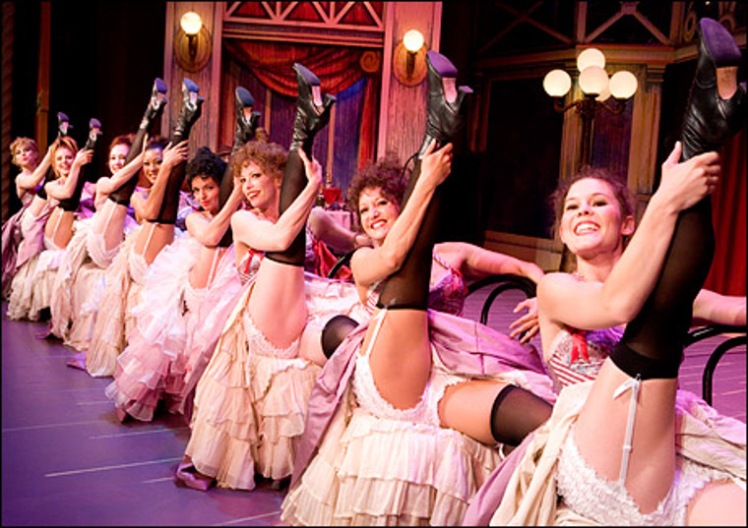 The cancan answered the question men have always asked. What do women have under their skirts? Legs.
The cancan answered the question men have always asked. What do women have under their skirts? Legs.
We remember Jacques Offenbach for the music he wrote for the dance called the cancan. It was called a galop (and it did). Offenbach was more significant than that (though it was one of the biggest pop hits of the 19th century). He created a tradition of musical theatre in Paris 1850-1880 that was popular around the world. Without Offenbach we would not have the Savoy Operas of Gilbert and Sullivan, and probably not the kind of musical exemplified by Loesser’s Guys and Dolls or the films of Baz Lurhman. Through his genius as a composer and the immense popularity of his work Offenbach virtually created the musical we know today, and is still by far its most important composer. Offenbach called his musical productions “opera” but we refer to them as “operetta”. I wondered why the different name. Both are misleading. Despite his success Offenbach was and is disparaged for not writing opera, or composing it badly.
The first operas
Opera began during the Italian Renaissance. The idea was first voiced in Florence about 1600 when editions of the plays of ancient Greece and Rome were circulating among scholars. It was known that in these works actors wore masks, that they included songs, that the chorus chanted their lines, and that the whole work had a musical accompaniment. But all trace of ancient music had been lost. All that remained was the texts and sometimes the names of characters in the drama.
Florentine scholars wondered if these works could be re-created and performed as they once had been. They were more familiar with the Latin tragedies of Seneca and the “low” comedies of Plautus and Terence than with the Athenian playwrights: and Aristophanes was considered “obscene”. The result of their efforts was opera as we know it, firstly with the work of Monteverdi, beginning with L’Orfeo, about the Greek myth of Orpheus and Eurydice, which was first performed in 1607. This developed into “serious opera”, “grand opera” and the works of Wagner and Verdi in the 19th century, and other operas being written still today. The ‘operas’ of Offenbach are completely unlike all these works.
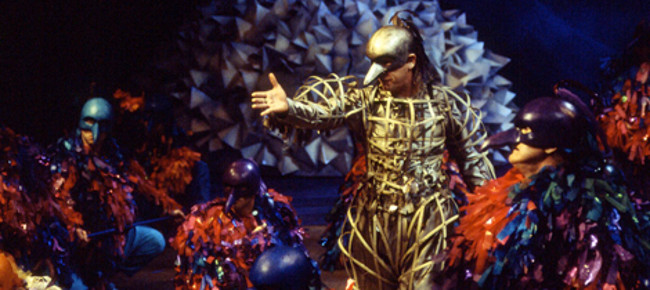 Aristophanes’ Birds pilloried venal office seekers in war torn Athens, and did so beautifully.
Aristophanes’ Birds pilloried venal office seekers in war torn Athens, and did so beautifully.
Other traditions
Opera was, broadly speaking, musical theatre. But there was another form of musical theatre active in 1600 and the whole Renaissance period, the commedia dell’arte, performed in masks by travelling actors, known as comici, who improvised the adventures of a number of stock characters, accompanied by a band of musicians. This was popular entertainment, certainly not the work of learned scholars, yet there were similarities with opera. Commedia dell’arte also had an ancient tradition, going back to the rhetoricians, mimes and popular performers in the classical world, including New Comedy and Roman farces.
Commedia dell’arte developed into the popular stage comedies of Shakespeare’s day, into pantomime, the satirical review, burlesque, vaudeville, striptease and sex shows, as well as musical plays for both stage and film. It was lowbrow entertainment, and music was always an important part of the show. This tradition is where Offenbach’s works really belong. We should really call them ‘musicals’.
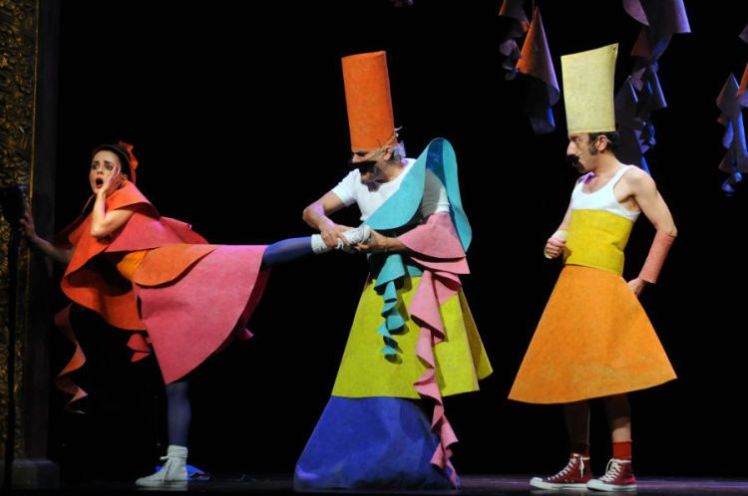 The surreal world of Aristophanes in a modern Greek play designed by Marie Noelle Semet.
The surreal world of Aristophanes in a modern Greek play designed by Marie Noelle Semet.
Confusion of traditions
Opera at first was scholarly and rather highbrow, in the tradition of humanist learning and with the prestige of classical antiquity behind it. Soon though variants of opera comprising works not as serious as opera once was began to appear in the repertoire of opera and have been given distinct names, such as comic opera (opera buffa or opéra buffon), ballad operas like the Beggar’s Opera, singspiel (“sing-speak”) e.g. The Magic Flute, or operetta (an opera of briefer duration). Confusingly the operettas of Gilbert and Sullivan are known as the Savoy Operas, and French opéra comique refers to operas that include spoken dialogue but which are not comical.
My theory is that as opera developed it incorporated elements of its rival tradition, the commedia dell’arte. At some stage in the late 18th century the two traditions of opera and commedia dell’arte were merged to a certain extent to form popular musical theatre called opera that suited all classes, satisfying the love of prestige of the upper classes and nouveau riche, while providing a sentimental or melodramatic love story or a comedy of manners with easily memorised tunes for all tastes. It was all called opera, but certain works more in the commedia dell’arte tradition were disparaged by the conservative as in bad taste, obscene, subversive and shocking. Wagner was treated with veneration and Verdi became a figure of national importance to all Italians as nationalism became a potent force to live and die for. Lovers of these composers saw Offenbach as a creator of ephemera.
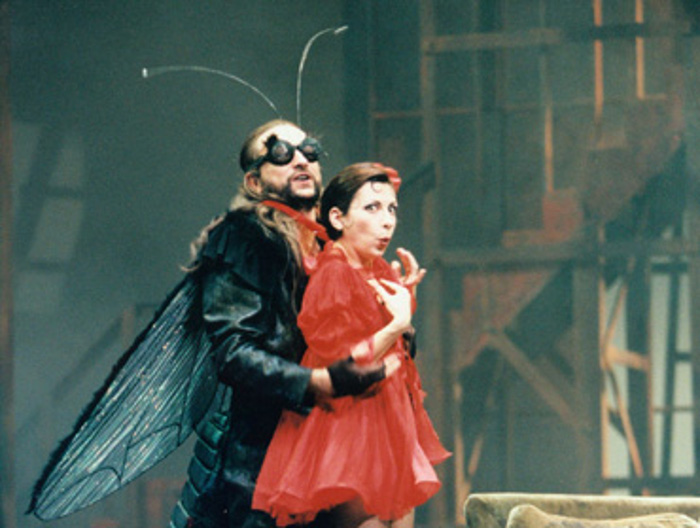 Eurydice falls in love with Pluto and enters the underworld. This unfortunately involves dying, so Jupiter, intent on seducing her, appropriately enough takes on the form of a fly.
Eurydice falls in love with Pluto and enters the underworld. This unfortunately involves dying, so Jupiter, intent on seducing her, appropriately enough takes on the form of a fly.
The formal distinction between these musical theatres, one for the cultured, one for the unlettered, was that all parts of an opera were sung, but more popular forms of musical theatre included both songs and spoken dialogue. They were consequently less demanding of the singers. In turn they required actors to be versatile: to act, dance, sing, perform acrobatic feats, duel with swords, and juggle.
By the mid nineteenth century the names of these two forms of musical theatre had become politicised, and going to the opera became a statement of one’s class and material prosperity. We are still making a similar claim today when we say we like opera, or admit, alternatively, to having enjoyed musicals like The Sound of Music or Cats. Opera, as a social activity, is still elitist, other forms of musical theatre defiantly populist (not to say of course that people don’t go to see opera or musicals for enjoyment).
Birth of a popular audience
As musical theatre became more formalised and elaborate it became expensive to mount, and relied on attracting large audiences. This popularity would not have been possible but for the creation of a new class of audience, the urban lower classes, in some cases possessing literacy. This market became a profitable source of income for those writers who could gauge popular taste. One of the first to see the potential of this as a source of income was Mozart, who was a major influence in many ways on Offenbach.
Wolfgang Mozart had written successful serious opera, and from 1781 had pioneered the role of the instrumental impresario in order to support himself away from the fickle favour of court patrons. Though Mozart remained in the by then tradition of opera, he moved from seria to buffa, and moved again to singspiel just before he died. It should be remembered that Mozart was only 35 when he died, and he probably considered his career was only starting, for all that he had been performing as an instrumentalist since the age of five. It is likely Mozart would have moved opera further towards popular theatre had he lived. Both Mozart and Rossini wrote operas based on plays by Beaumarchais, whose ferocious and funny satires offended the ancient régime, and showed that satire was another lure to bring audiences to popular theatre productions.
Offenbach in Paris
Jacques Offenbach came to Paris in 1833 from Cologne, aged 14, to pursue his studies as a cellist (his father had come from a town in Germany called Offenbach, which became a nickname, “the Offenbacher”, so he changed his name from Eberst to Offenbach in 1808). Over the next 20 years Jacques built a reputation for himself throughout Europe as a cello virtuoso, and as a conductor. What he had decided he wanted, though, was to compose for the popular theatre, and that was not so easy. As instrumentalist and conductor for the Opéra-Comique he presented several works to them for staging, and they were refused. The trouble was that Offenbach’s works were too topically satirical for the conservative Opéra-Comique. So in 1855 Offenbach leased a theatre and became a producer, as well as composer, of what we would call revues. These were light, short, one act farces that mocked fashionable trends and personages. Their form was partly dictated by the small size of the theatre Offenbach leased, and by current licensing laws. Right from the start Offenbach’s revues were very popular. He was to write almost 100 of them over the next 25 years. His was a popular, sometimes scandalous, success. Perhaps though, he still hankered after establishment acceptance, for he began to work intermittently on a more serious work he called The Tales of Hoffmann, still not fully completed when Offenbach died in 1880.
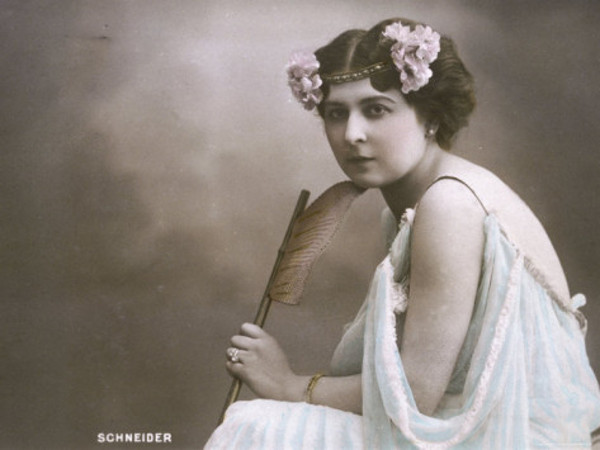 Hortense Schneider in her prime.
Hortense Schneider in her prime.
In 1855 Offenbach met two people to be quite important to him in the production and performance of his revues. One was the writer Ludovic Halévy, who wrote sparkling satires in collaboration with Henri Meilhac: the two were responsible for many of Offenbach’s most successful works, and their style perfectly matched the élan and brio of Offenbach’s music. The second was Hortense Schneider, one of the most celebrated actress-singers of the 19th century, whose career was launched in one of Offenbach’s first revues and who was his chief female singer in many of his productions. It was this quartet of outstanding talent that created the works that entertained audiences of the mid century, and left a legacy that inspired composers such as Sullivan, Strauss, Lehar, and Gershwin.
Another celebrated woman who appeared in Offenbach’s revues was Cora Pearl. She was a famous English ‘lady of fortune’, what we refer to as a call girl, the French as a fille de joie or demi-mondaine, not quite a prostitute but a woman with her sexual services for sale to the highest bidder. By the 1860s Cora was the mistress of several monarchs and prominent members of the French nobility, and had become fashionable in some less conservative societies. In 1867 she appeared in a production of Offenbach’s Orpheus in the Underworld. She took the part of Cupid in that revue, and appeared briefly clad, to contemporary eyes though not to ours accustomed as we are to more extreme nudity. All Paris (the men at any rate, the women being more blasé) flocked to see her.
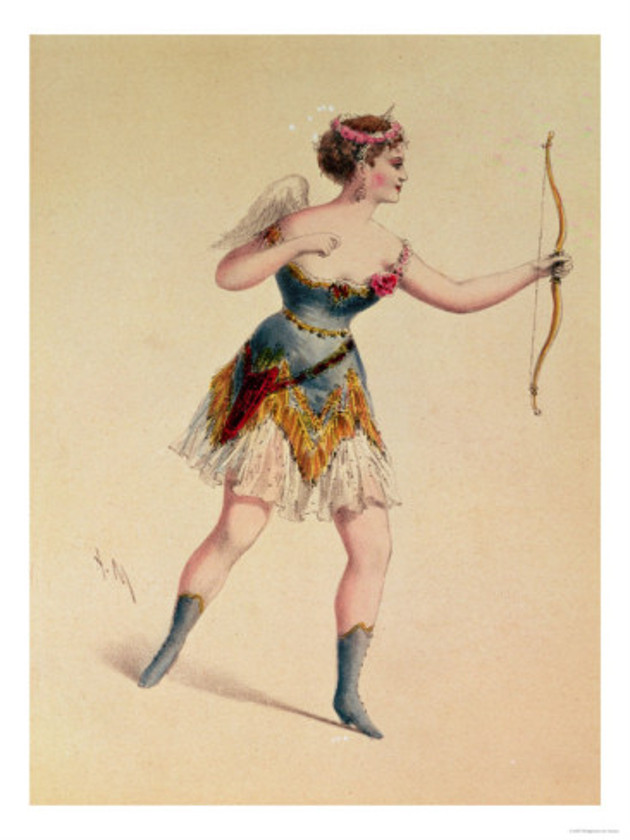 Cora Pearl in the costume that shocked audiences of the 1860s. They thought she was practically nude. Business boomed accordingly.
Cora Pearl in the costume that shocked audiences of the 1860s. They thought she was practically nude. Business boomed accordingly.
Musical theatre
Of Offenbach’s 99 productions of musical theatre 1847-1880, more than half, 57, are short one act farces or satires. Offenbach called his works variously opéra comique, bouffonnerie musicale, opérette, revue, and many other categorisations. They clearly did not fit into the established format of opera in either length, treatment or musical structure. But no-one realised at first that Offenbach had created something new. They were mostly very popular and therefore financially successful, yet even that created hostile criticism. Offenbach has been slighted, during and after his lifetime, as being somehow an unimportant composer because he did not write in the tradition of serious opera. Even his final work, The Tales of Hoffmann, though formally a sing-spiel or opéra comique, and performed usually as an opera, could be restaged as a cabaret quite effectively.
Although most of Offenbach’s work is entertaining, he is known today for a relatively few pieces. Orpheus in the Underworld of 1858, in which the sententious story of Orpheus travelling to the underworld to rescue Eurydice is exposed as a pious sham, as both are really in love with someone else, every one acts from self interested motives and Hell is filled with tiresome bores. The work was written by Halévy, and contains a treatment of classical myth reminiscent of Lucian of Samosata’s Dialogues of the Dead. There are many allusions to contemporaries in the text and music, including parodies of the court of Napoleon III and of the opera on the same subject by Gluck. The available version on DVD is from 1998 (123 min) and is directed by Laurent Pelly, with Natalie Dessay and Yann Beuron as Eurydice and Orphée, Laurent Naouri as Jupiter and Cassandre Berthon as Cupidon with the Orchestra and Chorus of the Opéra National de Lyon conducted by Marc Minkowski. Of note is the set design by Chantal Thomas, the costume design by Michel Dussarat and Pelly and the choreography by Dominique Boivin, all of which is brilliant. The storyline is updated, as Offenbach must be to retain the impact of his musical humour, and the work proceeds at breakneck speed, with inspired deployment of cast members to provide constant entertainment. This is no mere play with songs. The entire cast act skilfully while singing Offenbach’s beautiful melodies, and the second act contains the famous infernal galop which involves the entire cast in a version of the cancan (minus the traditional petticoats and black stockings, and much more entertaining).
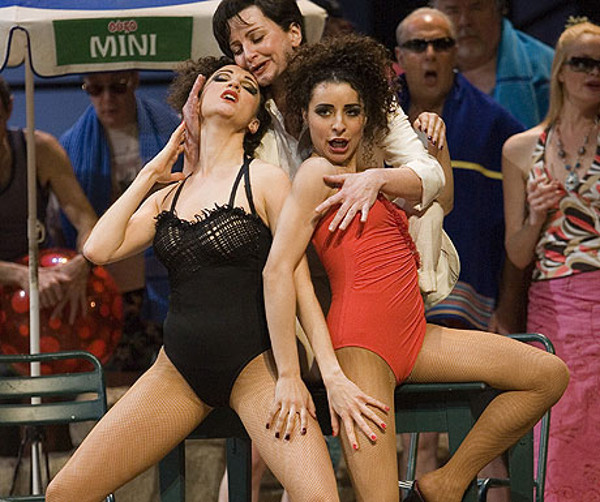 Magali Léger as Parthoenis, Marie-Ange Torodovitch as Orestes, and Stéphanie D’Oustrac as Leoena in La Belle Hélène. Fun at the beach and just another beauty contest.
Magali Léger as Parthoenis, Marie-Ange Torodovitch as Orestes, and Stéphanie D’Oustrac as Leoena in La Belle Hélène. Fun at the beach and just another beauty contest.
La Belle Hélène of 1864, written by Halévy and Meilhac, tells the real story of the award of the golden apple by Paris to the most beautiful of the goddesses Hera, Athena and Aphrodite. The tale is commented on by an oafish chorus of Greek heroes, Menelaus, Agamemnon, the two Ajaxes and Achilles, and is a sad story of greed, corruption and lust. Another parody of contemporary society using Greek myth to hilarious effect. The available DVD is from 2000, 127 min, directed by Laurent Pelly, with Felicity Lott as Helen, Yann Beuron as Paris, Laurent Naouri as Agamemnon, with the Chorus of the Musicians of the Louvre led by Sebastian Rouland, Les Musiciens du Louvre Grenoble conducted by Marc Minkowski, costumes by Pelly, sets by Chantal Thomas and choreography by Laura Scozzi. The sets veer suddenly from ancient Greece to modern beach scenes and the same absurd competition takes place everywhere.
In 1866 Offenbach bought out La vie parisienne, written by Halévy and Meilhac. This is a modern setting, without the disguise of Greek myth to obscure the barbs of its wit. A story that mocks all those who think of Paris as a city of love and romance. Here all the visitors are looking for sex from the ‘romantic’ locals, and they in turn fleece the tourists while looking for an easy lay. This is Offenbach’s most melodious and amusing work. The available DVD is from a 2007 performance (135 min) at Opera national de Lyon directed by Laurent Pelly with Jean-Sébastien Bou as Raoul, Marc Callahan as Boninet, Laurent Naouri as Le Baron and Maria Riccarda Wesseling as Métella. Orchestra and Chorus of l’Opéra national de Lyon directed by Sébastien Rouland, costumes by Pelly, sets Chantas Thomas and choreography by Laura Scozzi. This time the production crew have excelled themselves and the sets and choreography are extraordinary. The dancers perform hilarious and very skilled routines between acts, the setting has been modernised to a contemporary one, but the satire remains timeless.
Laurent Pelly has taken a central place in restaging the work of Offenbach. He has created a version of The Tales Of Hoffmann in San Francisco in June, and I really hope to see it on DVD. He could also transform the great opera by Offenbach’s close friend and protégé Bizet, Carmen (which was also scripted by Halévy and Meilhac).
Libretti are available here: http://www.cs.hs-rm.de/~weber/opera/libretto.htm, http://www.gutenberg.org/ebooks/15915 (Tales of Hoffmann), http://www.boosey.com/composer/Jacques+Offenbach (pay site).
 The abode of Jupiter, who finds life more entertaining in the Underworld with Eurydice. Heaven as a collection of large fluffy pillows.
The abode of Jupiter, who finds life more entertaining in the Underworld with Eurydice. Heaven as a collection of large fluffy pillows.
Jacques Offenbach stands at a central place in the history of popular entertainment. Looking backward there is the biting satire and absurd situations, the fantastic costumes and unusual dances of Aristophanes (and no doubt the great music, probably composed by Aristophanes as well). Looking forward, there is Gilbert and Sullivan, the cross fertilisation of genres created by George Gershwin, the musical farces of Fred Astaire and Ginger Rogers, the hits of Andrew Lloyd Webber and the films of Baz Lurhman. It seems a long way away from Renaissance opera. Despite his central place in a musical tradition different to opera, Offenbach’s music is unique, as unique as the music of Vivaldi, Bach or Mozart, as unique as the music of Strauss, Gershwin or Webber.
©2013 Original material copyright Phillip Kay. Images and other material courtesy Creative Commons. Please inform post author of any violation.
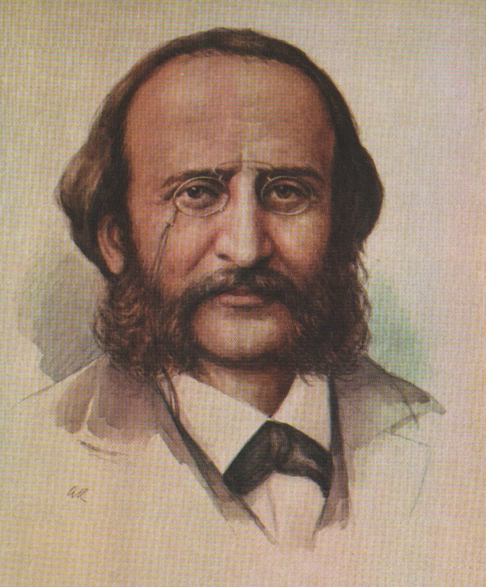
A nice job of leading us through the history and putting the various distinctions in perspective.